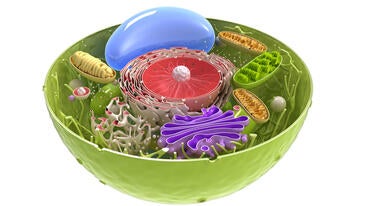
UC Riverside scientists have significantly advanced the race to control plant responses to temperature on a rapidly warming planet. Key to this breakthrough is miRNA, a molecule nearly 200,000 times smaller than the width of a human hair.
With moderate increases in temperature, plants grow taller to avoid hotter ground and get fresher air. A landmark study published in the journal Nature Communications demonstrates that microRNA or miRNA is required for this growth. The study also identifies which miRNA molecules — out of more than 100 possibilities — are the essential ones.
“We found that without miRNA plants will not grow, even if we raise temperatures, even in the presence of added growth hormones,” said UCR botany professor and study co-author Meng Chen.
RNA is a nucleic acid present in all living cells, and its role is to act as a messenger carrying instructions from a cell’s DNA for creating a variety of proteins. MicroRNA is also necessary for healthy development in biological cells. It is created to bind to a specific RNA target and prevent that target from creating what it was designed to manufacture.
“MiRNA inhibits the production of its target RNA by inducing a cleavage that destroys its RNA target, or by inhibiting the target RNA from being translated into another protein,” said UCR botany professor and study co-author Xuemei Chen.
Xuemei Chen’s lab at UCR helped discover miRNA in plants. Meng Chen’s laboratory previously identified components involved in the early stages of plants’ temperature sensitivity. The two groups of scientists joined forces to learn whether miRNA, which is so significant in plant development, also plays a role in plants’ temperature responses.
For this test, the scientists only looked at mild increases in temperature, from 21 to 27 degrees Celsius. For reference, room temperature averages about 20 C. “We didn’t look at heat stress responses. We wanted to study temperature sensing without raising it to a level that would kill the plants,” Meng Chen said.
"We wanted to focus on levels of heat that are more relevant to what plants are experiencing during the gradual increase in average global temperatures," he said.
The researchers took Arabidopsis, a small flowering plant related to mustard and cabbage, and studied mutant forms with very low levels of miRNA. Without the miRNA, the mutant Arabidopsis could not respond to the change in temperature by growing as it should have.
Then they did a genetics experiment. “We asked whether we could make additional mutations on the mutant Arabidopsis deficient in making miRNAs and restore their ability to respond to temperature,” Xuemei Chen said. The second experiment worked, “perfectly,” she said, and it revealed a gene responsible for restoring miRNA levels as well as the plant’s heat sensing abilities.
Next, the team faced a challenge in searching for the precise miRNA involved in temperature response. Arabidopsis manufactures 140 miRNA molecules. The scientists assumed levels of the responsible molecules would increase as temperatures did, but it didn’t happen that way.
Recalling that miRNA binds to and shuts down target RNA molecules, the team instead looked at target RNA molecule levels that were different in the original mutant Arabidopsis plant and in the second mutant plant they created.
“Looking at this we found the targets of 14 miRNA changed between the two mutants, and alongside the targets, we also found the miRNA,” Xuemei Chen said.
Having identified the right miRNA molecules, the team finally put together a comprehensive picture of how miRNA controls warm temperature responses. It involves two essential parts: molecules that sense temperature, and auxin, a hormone that generates a response to what’s been sensed by promoting plant growth.
“In between the sensor and the responder is miRNA. Without it, plants can sense heat but cannot respond to it by growing. It is a gatekeeper that can shut down — or allow — plants to react to environmental temperature changes,” Meng Chen said.
During their experiments, the team found the miRNA is also required for plants’ response to reflected shade from neighboring plants.
“Our discovery connected the dots between three elements found in all plants that are key for plant responses to their environments,” Meng Chen said. “This includes sensors that monitor temperature and light changes, hormones that drive plant growth, and miRNA that controls the plant's responsiveness to environmental changes.”
The researchers hope their findings can be used to increase crop yields as the climate changes.
“The potential is that we use this to engineer plant responses to local temperature and light conditions and control their growth in diverse environments,” Meng Chen said.
(Cover image: amenic181/iStock/Getty)






